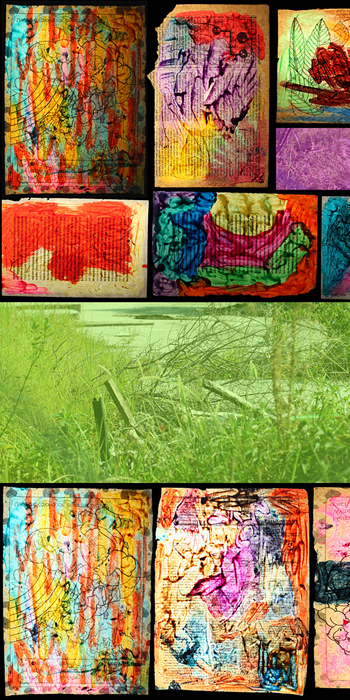Jim Drain Wants to Make The Gap of Art

Jim Drain first garnered buzz (and fuzz) for wookie-like sculptures he created as part of the Providence, RI based art collective Forcefield. Long since relocated to Miami, Drain’s solo art practice has expanded over the years to include hippie collages, woven wall coverings and wearable textiles, all executed in an array of brightly psychedelic colors.
To coincide with this year’s Art Basel Miami Beach, Drain will exhibit a new public artwork, created with the support of art collectors Rosa de la Cruz, Asi Cymbal and Craig Robins in the Miami Design District. Debuting on November 29—and viewable through July of next year—Drain’s “Small Reprieve” wraps a construction site at NE 40th St and North Miami Avenue with colorful imagery generated by layering photo-collages and drawings beneath luminous colors created by melting crayons. (The construction site will eventually become a retail complex designed by the Mexican architect Enrique Norten.)
We spoke with Drain about working on the piece with 9th grade students from the local D.A.S.H. high school, and about how fashion can inspire art.
KEN MILLER: Was the location for the NE 40th installation selected by you or by the Miami Design District? Does this vacant lot have a particular meaning for you?
JIM DRAIN: My friend Clif pulled some plants out of the lot last year for his wedding – there are some nice plants growing wild in the lot. It is like there a chunk of the Design District that’s moving back in time, back to “dino-land.”
MILLER: Do you have a favorite piece of public art?
DRAIN: Cleveland’s got it! I grew up with the “Free Stamp” by Claes Oldenburg and Coosje van Bruggen. There is also a Rodin Thinker that was blown up with sticks of dynamite in the ’70s, which is cool. There was also a rash of smoking pipe silhouettes that sprang up in my neighborhood when I was in high school, which is weird and hard to explain.
MILLER: Do you feel that public art should be approached differently than gallery art?
DRAIN: Public art is [like] The Gap. With clothing and fashion the language changes—the gloves come off and we all can participate. [Like fashion], public art is participatory, it is shared. Clothing is viral, impermanent in a way that public art cannot be. So I like thinking of how corporate-created clothing can be seen as a form of public art.
MILLER: This piece is site-specific… Did you approach it with any preconceived notion of what you’d make?
DRAIN: I did not want to hide the fact that there is a crappy lot there, so I wanted to bring out what I liked most about the site. It seemed to work with the drawings I was making with the D.A.S.H. kids, where the fence became a window rather than a wall.
MILLER: Did you approach the students at D.A.S.H. high school just for this project or have you been working with them previously?
DRAIN: They were helping me with the aim of making works with me for the Locust Projects show that’s opening on December 3rd. I re-learned that teenagers are evil and amazing. They were up for anything and really got into it.
MILLER: You’ve been living in Miami for a few years now. What have you grown to appreciate about the place?
DRAIN: That southern Florida is a giant, ancient coral reef that is still alive and the flora and fauna—mangroves, orchids, cycads, avocados, lychee, strangler figs, to name a few—are ever-inspiring; that “Flori-duh” really exists; and that birdwatchers are fanatics.
MILLER Is it weird having the art world show up on your doorstep once a year?
DRAIN: Yes.






